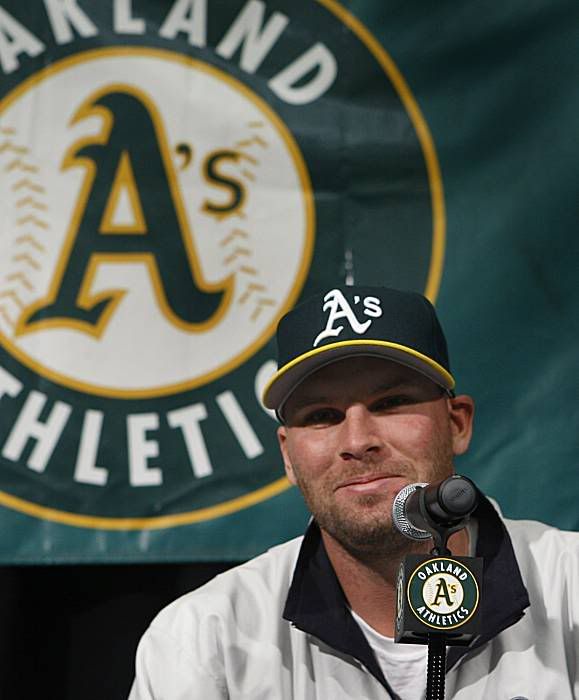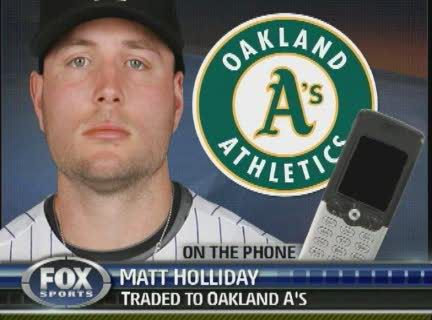Much has changed in the six years since Michael Lewis’ groundbreaking book, Moneyball, brought the Oakland A’s and Billy Beane’s unorthodox management strategies into the public sphere.
Tampa Bay is the reigning AL Champion, the Yankees spent a mindboggling $400 plus million in the offseason (on 3 free agents) and Oakland sits dead last in the uncelebrated AL West.
Could we all see this coming?
Some would argue that 2009 is an anomaly, a speedbump in Oakland’s next rise to prominence.
Some say it’s just bad timing; the market readjusted during a rebuilding season. Others, however, are more certain of the causes.
Moneyball has failed.
Billy Beane is a fraud.
Haters are unanimous in their outcry.
Just ask a Giants fan.
As they chase the NL wild card from their China Basin digs, they look across the Bay and see an aging, cavernous ballpark, a small time payroll, and a revolving door of Oakland’s most celebrated players.
They see bush league.
KNBR newsies coined a cute little phrase: “The AAA’s”… as in: all prospects, no major league talent.
Needless to say, Giants fans with short memories love this.
Unlike the A’s, the men in orange and black have not enjoyed a winning season in years, so they’re riding this wave for all it’s worth. Part of the ride means boasting a nouveau-riche dismissal of moneyball, as a concept, and Beane, as its executor.
Whatever Moneyball means, it doesn’t mean much in Oakland right now.
But maybe there is some value in what happened earlier this decade.
Maybe there are other franchises who have taken direction from what Billy Beane did a few years ago. Maybe a good example would be the Red Sox. Maybe the Yankees, the Dodgers, and even the Giants have followed suit.
So maybe we should qualify some terms. What IS “Moneyball”?
In its purest sense, Moneyball means finding value in undervalued assets.
As in Bobby Abreu or Jason Giambi. They’re old. Their best years are behind them, and that means they could come at a dramatic discount, like say: $5 million, as opposed to $17 million, which is what happened to Abreu.
Deals can be found when one is willing to reconsider “value”.
In other words: Buy Low.·
Conversely, one can exploit the market by trading away over-valued assets, like, say, two months of Matt Holiday, for five years of three high level prospects.
Because the 2009 A’s were not in a playoff push, the value of two months of Holiday is low. But to the Cardinals, who are trying to make the post season, those 2 months are an extremely valuable commodity.
In other words: Sell high.
The other essential component of Moneyball is finding undiscovered value by using new, innovative methodologies.
In Lewis’ book, the A’s realized that batting average and RBIs were misleading stats that teams payed too much for. So instead, they targeted palyers with high on base percentage because those highly disciplined hitters flew under the radar of other teams, and could thus be acquired by Oakland’s limited budget.
Both BA and OBP are offensive metrics, but only one was dramtically undervalued.
Finally, the Moneyball philosphy placed unpercedented importance on the draft, and building teams inetrnally.
The A’s could never sign a free agent like Mark Texiera. Small market teams do not patriciptae in the bid-high world of free agency, so they have to build teams through their minor league systems and the draft.
They used homegrown methods to develop homegrown prospects and thus built teams from the inside.
To the average fan, those all seem like pretty sound concepts.
But haters remind us that the A’s are 49 - 62.
Obvisouly Moneyball has failed, right?
Wrong.
The success of the Moneyball philosophy is not limited to green and gold. In fact, big market teams may be the best exapmples of Moneyball at work, and the greatest testament to Moneyball is the adoption of its practices by teams who didn’t have to use them.
As ESPN’s Buster Olney points out:
“Big-market teams, such as the Red Sox and Yankees, smartly began to drink from the same draft-and-develop trough that the Athletics, and others had drawn for years.”
Granted, the A’s haven’t exactly put up lights-out numbers these past few years.
There are many explanations for this, but perhaps the most convincing is what Olney suggests: that the secret’s out.
Once Lewis’ book was released in 2003, and the dirt-broke A’s posted three consecutive 95 plus win seasons, teams started to take notice.
All of a sudden, clubs began to reconsider how they evaluated talent. According to ESPN’s Howard Bryant, “Beane became the lead evangelist of a new baseball orthodoxy that emphasizes greater statistical analysis in the scouting and development of players”.
Baseball was getting smarter.
A new school of baseball thinking was being quietly ushered in.
The Boston Red Sox were early adopters.
In 2003, they offered Beane the largest contract in history to lead their club. He declined, and decided to stay in Oakland. So, instead, they decided to implement the strategies he made famous.
Boston CEO Larry Lucchino hired fellow SaberMetrics aficionado, Theo Epstein, to replenish their nascent farm system and minor league affiliates. They nurtured high OBP players like Kevin Youklis and Dustin Pedroia into some of the most fearsome hitters in the game today, and built stables of young pitching around prospects like Josh Beckett and Jonathan Papelbon. They also used their deep pockets to acquire big time free agents like Manny Ramirez, and, viola—no more curse.
As Red Sox Lucchino admitted:
“Billy Beane is a sharp mind. We tried to hire him, but what we've done since Theo took over is to take some of the quantitative analysis approaches and overlay them with the resource advantages of our market."
In essence, what Boston did was marry Moneyball with money.
The result: 2 World Series titles in the last 5 years.
Not to be outdone, the Yankees began efforts to draft smarter.
In GM Brian Cashman’s own words:
“Statistical analysis comes into play in defining the reality of the performance. Trends that show risk, injury, regression -- maybe you can catch that earlier because it's definable.”
The key similarity with Boston (and advantage over Oakland) is that Yankees don’t have to substitute one value for another. They can buy any combination of OBP and home runs. The idea that Brian Cashman’s checkbook is consulting Billy Beane’s notebook can be a scary thought for the rest of baseball.
More examples?
How about them Dodgers?
In 2004, LA hired former A’s assistant GM Paul DePodesta to bring some of that analytical Oakland A’s magic to the NL.
He took them to the playoffs in 2004 and went on to champion the tenets of Moneyball in San Diego, where he took the Padres to the NL West Divisional series in 2006 and 2007.
So, haters, please take note; Moneyball is NOT dead.
It is alive and well.
It has evolved into industry standard knowledge, and has improved the efficiency of any team willing to give it a try.
And where does this leave the A’s?
The reality is, that Oakland still sits in the bottom ten of all Major League payrolls.
Resources are limited. And now that Beane’s innovations have been exploited by everyone else, they face a new burden of having to re-innovate further advances.
At this point, rebuilding via trades has seemed to be the most productive route.
Clichés aside, 2009 is a rebuilding season. Oakland has five talented 22 year-old starting pitchers locked in for the next four seasons.
Despite this year’s numbers, Beane has to like his chances going forward.
For the remaining haters, consider this: no team aside from New York and Boston has won more games since 2000 than the Oakland A’s.
What has your GM done for baseball lately?



